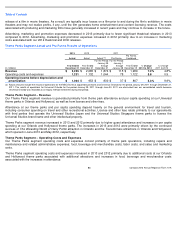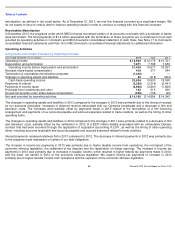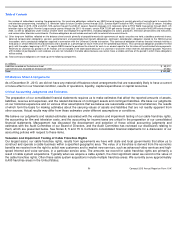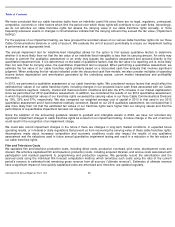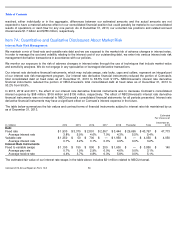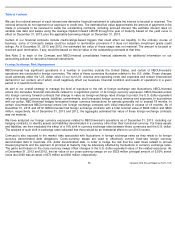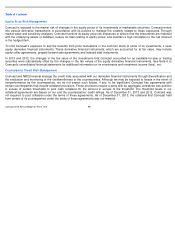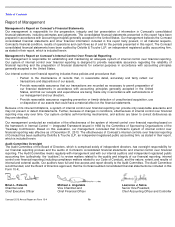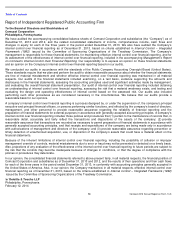Comcast 2013 Annual Report Download - page 77
Download and view the complete annual report
Please find page 77 of the 2013 Comcast annual report below. You can navigate through the pages in the report by either clicking on the pages listed below, or by using the keyword search tool below to find specific information within the annual report.
Table of Contents
We have concluded that our cable franchise rights have an indefinite useful life since there are no legal, regulatory, contractual,
competitive, economic or other factors which limit the period over which these rights will contribute to our cash flows. Accordingly,
we do not amortize our cable franchise rights but assess the carrying value of our cable franchise rights annually, or more
frequently whenever events or changes in circumstances indicate that the carrying amount may exceed the fair value (“
impairment
testing”).
For the purpose of our impairment testing, we have grouped the recorded values of our various cable franchise rights into our three
Cable Communications divisions or units of account. We evaluate the unit of account periodically to ensure our impairment testing
is performed at an appropriate level.
The annual impairment test for indefinite-
lived intangibles allows for the option to first assess qualitative factors to determine
whether it is more likely than not that the fair value of an indefinite
-
lived intangible is less than its carrying amount. An entity may
choose to perform the qualitative assessment or an entity may bypass the qualitative assessment and proceed directly to the
quantitative impairment test. If it is determined, on the basis of qualitative factors, that the fair value of a reporting unit is, more likely
than not, less than its carrying value, the quantitative impairment test is required. When performing a quantitative assessment, we
estimate the fair value of our cable franchise rights primarily based on a discounted cash flow analysis that involves significant
judgment. When analyzing the fair values indicated under the discounted cash flow models, we also consider multiples of operating
income before depreciation and amortization generated by the underlying assets, current market transactions and profitability
information.
In 2013, we performed a qualitative assessment of our cable franchise rights. We considered various factors that would affect the
estimated fair values of our cable franchise rights, including changes in our projected future cash flows associated with our Cable
Communications segment, industry, market and macroeconomic conditions and also the 27% increase in our market capitalization
since we performed our 2012 quantitative assessment. In addition, we considered the results of our 2012 quantitative assessment,
in which the estimated fair values of our franchise rights exceeded the carrying value in our three Cable Communications Divisions
by 19%, 33% and 37%, respectively. We also compared our weighted average cost of capital in 2013 to that used in our 2012
quantitative assessment and it had remained relatively consistent. Based on our 2013 qualitative assessment, we concluded that it
was more likely than not that the estimated fair values of our franchise rights were higher than our carrying values and that the
performance of a quantitative impairment test was not required.
Since the adoption of the accounting guidance related to goodwill and intangible assets in 2002, we have not recorded any
significant impairment charges to cable franchise rights as a result of our impairment testing. A future change in the unit of account
could result in the recognition of an impairment charge.
We could also record impairment charges in the future if there are changes in long-
term market conditions, in expected future
operating results, or in federal or state regulations that prevent us from recovering the carrying value of these cable franchise rights.
Assumptions made about increased competition and economic conditions could also impact the results of any qualitative
assessment and the valuations used in future annual quantitative impairment testing and result in a reduction in the fair values of
our cable franchise rights.
Film and Television Costs
We capitalize film and television production costs, including direct costs, production overhead, print costs, development costs and
interest. We amortize capitalized film and television production costs, including acquired libraries, and accrue costs associated with
participation and residual payments to programming and production expense. We generally record the amortization and the
accrued costs using the individual film forecast computation method, which amortizes such costs using the ratio of the current
period’s revenue to estimated total remaining gross revenue from all sources (“ultimate revenue”).
Estimates of ultimate revenue
have a significant impact on how quickly capitalized costs are amortized and, therefore, are updated regularly.
Comcast 2013 Annual Report on Form 10
-
K
72



